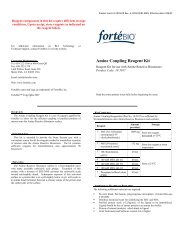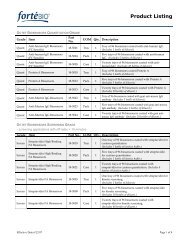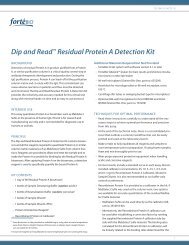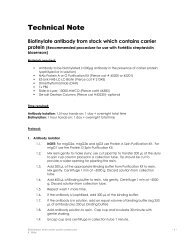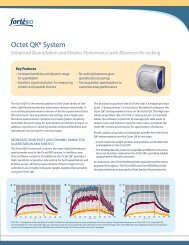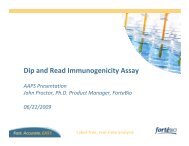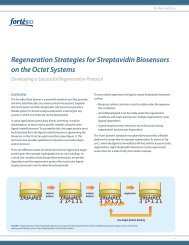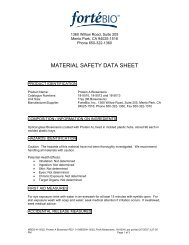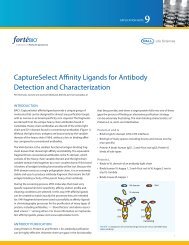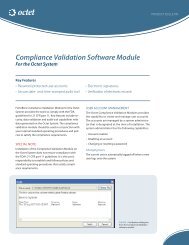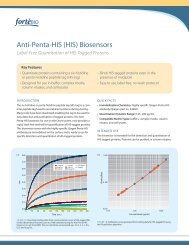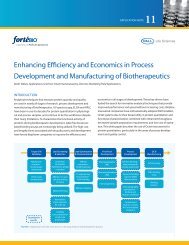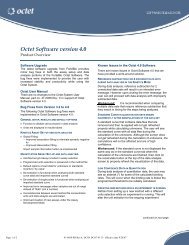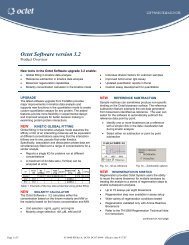E. coli - ForteBio
E. coli - ForteBio
E. coli - ForteBio
You also want an ePaper? Increase the reach of your titles
YUMPU automatically turns print PDFs into web optimized ePapers that Google loves.
Detecting Common Food-borne<br />
Pathogens Using KPL BacTrace ®<br />
Antibodies and the Octet RED96<br />
Dr. Brian Bullard<br />
R&D Scientist, Kirkegaard & Perry Labs<br />
Gaithersburg, MD
Who KPL Is<br />
• Founded 1979, KPL developed the first affinity-purified polyclonal antibodies<br />
• KPL offers >800 catalog products<br />
• Offer kits and applications for protein detection and labeling<br />
– ELISA, Western blot, Immunohistology<br />
• Polyclonal antibodies<br />
– Secondary antibodies & conjugates<br />
– Primary antibodies against bacteria
• Model System<br />
Outline<br />
• Initial Studies with Intact Bacteria<br />
• Improving Sensitivity<br />
• Improving Signal<br />
• Complex Matrices<br />
• Future Directions
E. <strong>coli</strong> O157:H7<br />
• Gram-negative bacterium<br />
• Food-borne pathogen<br />
– Causative agent of the Jack In The Box outbreak in<br />
the early 90’s<br />
• Easy to grow<br />
• Anti-E. <strong>coli</strong> O157:H7 is well studied
ELISA Data Demonstrating the Specificity of<br />
Polyclonal Anti-E. <strong>coli</strong> O157<br />
OD (405 nm)<br />
2.0<br />
1.8<br />
1.6<br />
1.4<br />
1.2<br />
1.0<br />
0.8<br />
0.6<br />
0.4<br />
0.2<br />
0.0<br />
Heat Fixed<br />
Chemically Fixed<br />
E. <strong>coli</strong> O157:H7 KPL<br />
E. <strong>coli</strong> O157:H7 ATCC<br />
E. <strong>coli</strong> O1:H7<br />
E. <strong>coli</strong> K12<br />
E. <strong>coli</strong> ATCC<br />
E. <strong>coli</strong> O125a<br />
E. <strong>coli</strong> O128a,128b:H<br />
E. <strong>coli</strong> O111:H8<br />
E. <strong>coli</strong> O124:NM<br />
E. <strong>coli</strong> O26:K60<br />
E. <strong>coli</strong> O29:NM<br />
Citrobacter freundii<br />
Edwardsiella tarda<br />
Enterobacter cloacae<br />
Hafnia alvei<br />
Klebsiella pneumoniae<br />
Providencia Stuartii<br />
Salmonella typhimurium<br />
Serratia marcescens<br />
Shigella flexneri<br />
Shigella sonnei<br />
Staphylococcus aureus<br />
Yersinia ruckeri
Why is KPL Using an Octet to Detect<br />
Bacteria?<br />
• Improved speed and sensitivity<br />
• Compatibility with complex matrices<br />
• Improved in-process testing of<br />
antibodies/antisera<br />
• Improved understanding of customers’ needs<br />
when working with Bio-Layer Interferometry<br />
(BLI)
Whole Bacteria: Culture Manipulation<br />
Grow E. <strong>coli</strong><br />
Plate dilutions to<br />
determine cfu/ml<br />
Scrape colonies off<br />
the plate and<br />
suspend in buffer<br />
10-fold Serial Dilution<br />
Assay on Octet<br />
RED96
Protein G<br />
Biosensors<br />
Whole Bacteria: Detection<br />
Regenerate and<br />
Wash (x3) Antibody Load<br />
(300 sec.)<br />
Protein G Biosensor<br />
Block w/ Goat<br />
Serum (300 sec.)<br />
Baseline<br />
(180 sec.)<br />
Capture Bacteria<br />
(300 sec.)
l (nm)<br />
0.45<br />
0.25<br />
0<br />
The Octet Can Detect Intact Bacteria<br />
E. <strong>coli</strong> O157 detected with anti-E. <strong>coli</strong> O157 Ab<br />
8.5 x 10 8 cfu/ml<br />
8.5 x 10 7 cfu/ml<br />
0 60 120 180 240 290<br />
Since bacteria Time are (seconds) so massive, why is<br />
the limit of detection so poor?
Why Aren’t Bound Bacteria Inducing More<br />
Signal?<br />
• Bacteria are massive compared to the<br />
antibodies on the surface on the tip<br />
– ~950 bacteria should be able to bind the tip under<br />
perfect conditions<br />
• Bacteria aren’t all that dense<br />
– Mostly water, which light can penetrate easily<br />
– E. <strong>coli</strong> are Gram-negative and have a thin cell well<br />
• Bacteria are odd shaped<br />
– Comparing a cube to a football<br />
– Leads to inefficient loading at the tip surface
Simulating Very Dense Particles<br />
Goat-<br />
Anti-<br />
Rabbit<br />
Baseline<br />
(30 sec.)<br />
x56<br />
Rabbit-<br />
Anti-<br />
Goat<br />
Protein G Biosensor<br />
Baseline<br />
(30 sec.)
l (nm)<br />
200<br />
150<br />
100<br />
50<br />
Results from Antibody Layering<br />
Raw Sensor Data<br />
0<br />
0 2000 4000 6000 8000 10,000 12,000 14,000 16,000<br />
Time (Seconds)
l (nm)<br />
Subtracted<br />
Data<br />
0.60<br />
0.40<br />
0.20<br />
0<br />
200<br />
150<br />
100<br />
50<br />
0<br />
Differences in Y-Axes<br />
Raw Sensor Data<br />
Time
Improving Detection Limit<br />
Intact Bacteria Antibody Layering<br />
Antibody<br />
(10 nm)<br />
Biosensor (1900 mm 2 )
Improving Detection Limit<br />
Intact Bacteria Disrupted Bacteria<br />
Antibody<br />
(10 nm)<br />
Biosensor (1900 mm 2 )
Disrupted Cells: Culture Manipulation<br />
Grow E. <strong>coli</strong><br />
Assay on Octet<br />
RED96<br />
Scrape colonies of the<br />
plate and suspend in<br />
buffer<br />
Pellet for 2 min.<br />
Bath Sonicate for 30 min.<br />
in EDTA + 1% Triton-X<br />
10-fold Serial Dilution<br />
Plate dilutions to<br />
determine cfu/ml
Protein G<br />
Biosensors<br />
Disrupted Cells: Detection<br />
Regenerate and<br />
Wash (x3)<br />
Protein G Biosensor<br />
Antibody Load<br />
(300 sec.)<br />
Block w/ Goat<br />
Serum (300 sec.)<br />
Baseline<br />
(180 sec.)<br />
Capture Bacteria<br />
Particles (300 sec.)
l (nm)<br />
Disrupting Cells Improves Detection Limit<br />
0.45<br />
0.25<br />
5 x 10 8 cfu/ml<br />
5 x 10 7 cfu/ml<br />
5 x 10 6 cfu/ml<br />
5 x10 5 cfu/ml<br />
5 x 10<br />
0<br />
0 60 120 180 240 290<br />
Time (seconds)<br />
4 cfu/ml<br />
Previous limit was 8.7 x 107 cfu/ml<br />
Can we improve sensitivity even more?
How to Increase Sensitivity<br />
• Disrupt bacterial cells more efficiently<br />
– Add glass beads to sonication mixture<br />
• Increase “density” of the bacteria<br />
– Gold labeled antibody<br />
– Precipitating substrate<br />
• Metal Enhanced DAB<br />
– Increased capture duration
Disrupted Cells: Culture Manipulation<br />
Grow E. <strong>coli</strong><br />
Assay on Octet<br />
RED96<br />
Scrape colonies of the<br />
plate and suspend in<br />
buffer<br />
Pellet for 2 min.<br />
Bath Sonicate for 30 min.<br />
in EDTA + 1% Triton-X<br />
10-fold Serial Dilution<br />
Plate dilutions to<br />
determine cfu/ml
Disrupted Cells + Enzymatic Reaction:<br />
Detection<br />
Streptavidin<br />
Biosensors<br />
Biotin<br />
Streptavidin<br />
Biotin<br />
Biosensor<br />
Biotin Biotin Biotin<br />
HRP HRP HRP HRP HRP<br />
Antibody Load<br />
(300 sec.)<br />
Incubate with<br />
Metal Enhanced<br />
DAB<br />
Block w/ Goat<br />
Serum (600 sec.)<br />
Baseline<br />
(30 sec.)<br />
Block w/ Goat<br />
Serum (300 sec.)<br />
Block w/ Goat<br />
Serum (300 sec.)<br />
Capture Bacteria<br />
Particles (300 sec.)<br />
HRP
l (nm)<br />
Use of Metal Enhanced DAB Gains ~1 Log of<br />
Sensitivity<br />
30.00<br />
15.00<br />
5.5 x 10 5 cfu/ml<br />
0<br />
0 60 120 180 240 290<br />
Time (seconds)<br />
5.5 x10 4 cfu/ml<br />
5.5 x 10 3 cfu/ml
What Else Can Be Done to Improve<br />
Sensitivity?<br />
• Factors to Consider:<br />
– Capturing bacteria with polyclonal antibody<br />
– Bacteria/particles are NOT uniform<br />
• Longer bacterial incubation time would<br />
increase particles captured on the tip surface<br />
– Necessitates the use of sandwich assay due to<br />
offline capture of bacteria
Disrupted Cells: Culture Manipulation<br />
Grow E. <strong>coli</strong><br />
Assay on Octet<br />
RED96<br />
Scrape colonies of the<br />
plate and suspend in<br />
buffer<br />
Pellet for 2 min.<br />
Bath Sonicate for 30 min.<br />
in EDTA + 1% Triton-X<br />
10-fold Serial Dilution<br />
Plate dilutions to<br />
determine cfu/ml
Disrupted Cells + Enzymatic Reaction:<br />
Detection<br />
Streptavidin<br />
Biosensors<br />
Biotin<br />
Streptavidin<br />
Biotin<br />
Biosensor<br />
Biotin Biotin Biotin<br />
HRP HRP HRP HRP HRP<br />
Antibody Load<br />
(300 sec.)<br />
Incubate with<br />
Metal Enhanced<br />
DAB<br />
Block w/ Goat<br />
Serum (600 sec.)<br />
Baseline<br />
(30 sec.)<br />
Block w/ Goat<br />
Serum (300 sec.)<br />
Block w/ Goat<br />
Serum (300 sec.)<br />
Off-line Capture of<br />
Bacteria Particles<br />
(22.5 hours)<br />
HRP
Offline Capture of Bacteria in Combination with<br />
Metal Enhanced DAB Yields Best Sensitivity<br />
3 x 10 3 cfu/ml<br />
3 x 10 2 cfu/ml<br />
Now we can detect 30 bacteria/ml!<br />
3 x 10 1 cfu/ml
Bacteria in Hamburger Extract: Culture<br />
Manipulation<br />
Grow E. <strong>coli</strong><br />
10-fold Serial Dilution in<br />
Hamburger Extract<br />
Wash Cells in PBS<br />
10-fold Serial Dilution<br />
in PBS<br />
Assay on Octet<br />
RED96<br />
Plate Dilutions to<br />
Determine cfu/ml
Bacteria in Hamburger Extract : Detection<br />
Streptavidin<br />
Biosensors<br />
Biotin<br />
Regenerate and<br />
Wash (x3) Antibody Load<br />
(300 sec.)<br />
Streptavidin Biosensor<br />
Biotin<br />
Biotin<br />
Biotin<br />
Biotin<br />
Block w/ Goat<br />
Serum (300 sec.)<br />
Baseline<br />
(180 sec.)<br />
Capture Bacteria<br />
Suspended in Hamburger<br />
Extract (300 sec.)
l (nm)<br />
Bacteria in Hamburger Extract are Detected<br />
as Well as in PBS<br />
0.45<br />
0.25<br />
E. <strong>coli</strong> O157 detected with anti-E. <strong>coli</strong> O157 Ab<br />
0<br />
0 60 120 180 240 290<br />
Time (seconds)<br />
9.7 x 10 8 cfu/ml<br />
9.7 x 10 7 cfu/ml
Summary<br />
• The Octet RED96 can be used to detect<br />
bacteria in complex matrices<br />
• Bacterial disruption can improve the limit of<br />
detection<br />
• The use of metal enhanced DAB, which<br />
precipitates on the biosensor, increases signal<br />
and sensitivity
Octet vs. Traditional Methods<br />
Traditional Methodology<br />
• Assay requires several<br />
hours<br />
• Limit of sensitivity is about<br />
10 4 bacteria<br />
• Often require enrichment<br />
• Bacterial suspension limited<br />
to buffers (e.g. PBS)<br />
Octet Methodology<br />
• 8 samples can be assayed<br />
in as little < 45 minutes<br />
• Limit of sensitivity < 10 2<br />
• Does not require<br />
enrichment<br />
• Compatible with complex<br />
matrices
Future Studies<br />
• Shortening the off-line incubation time<br />
• Detecting other food-borne Gram-negative<br />
bacteria<br />
• Detection of Gram-positive bacteria<br />
• Detecting bacteria with monoclonal antibodies<br />
against toxins or surface exposed epitopes<br />
• Quantification experiments
Acknowledgements<br />
KPL R&D Team
Questions?
Monoclonal Antibodies<br />
Polyclonal vs. Monoclonal<br />
Reporter<br />
Reporter<br />
Polyclonal Antibodies<br />
Reporter<br />
Reporter Reporter<br />
Reporter




